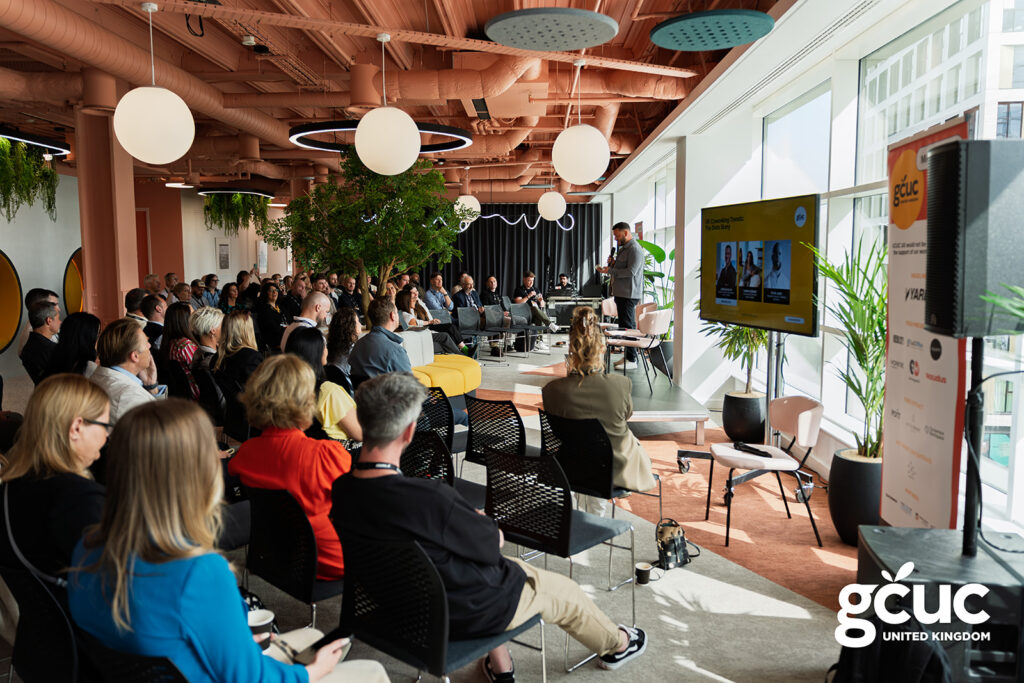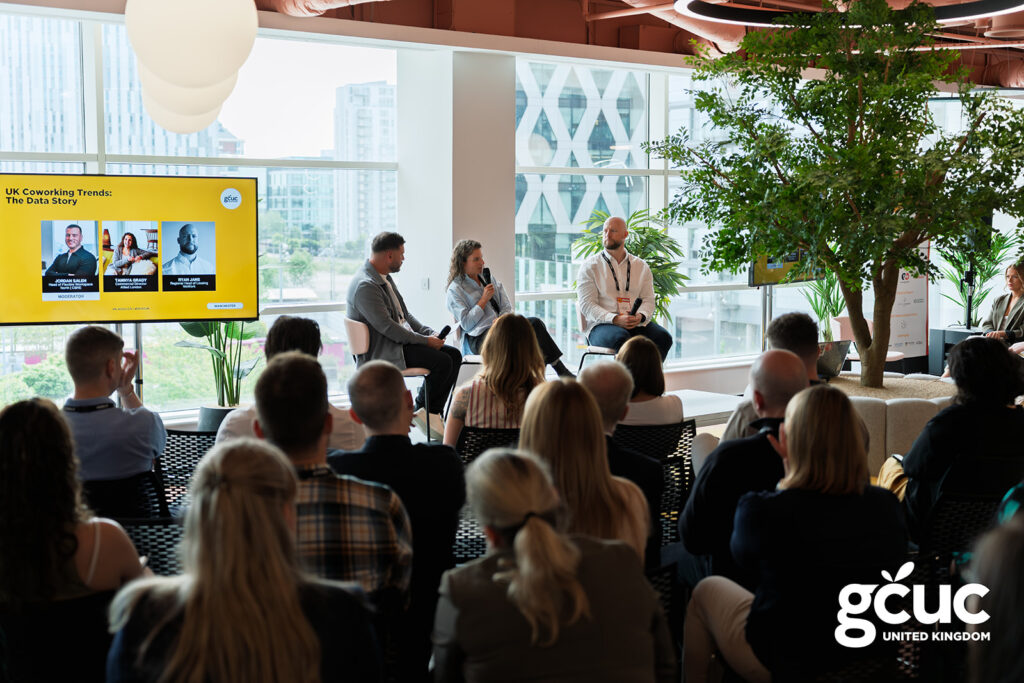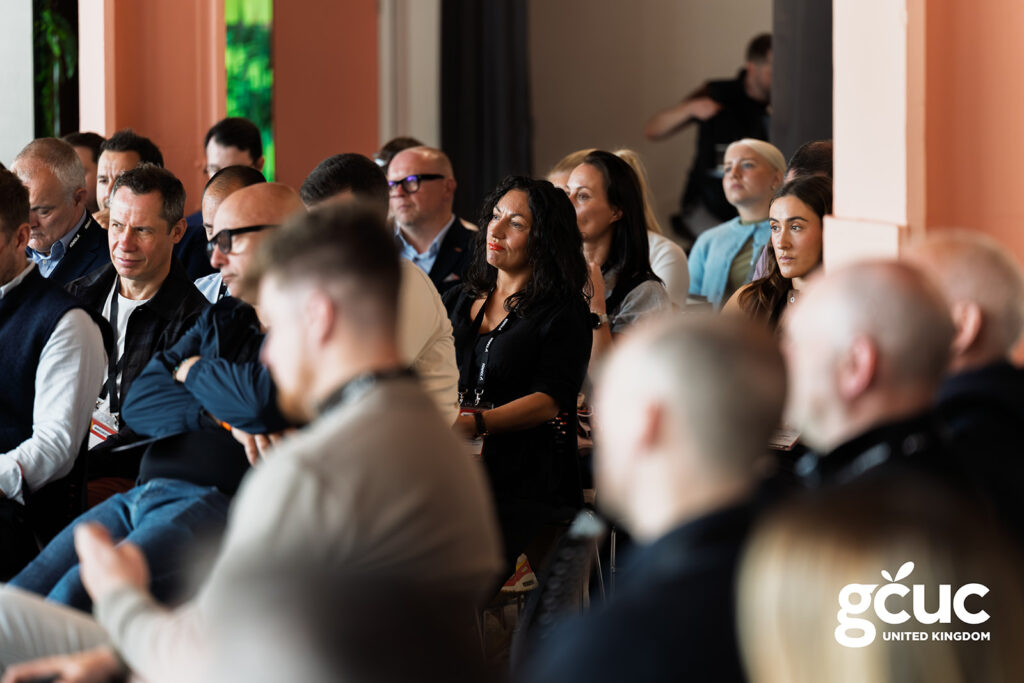
Insights from GCUC UK’s data panel with Jordan Saleh (CBRE), Ryan Jans (WeWork), and Tanya Grady (Allied London)
Jordan Saleh kicked off GCUC UK Manchester with what might be the best opening to a data presentation we’ve ever heard. Picture this: “Once upon a time, in a land of long leases and cubicle kingdoms, the office world was ruled by giants…”
What followed wasn’t your typical death-by-PowerPoint data dump, but rather a refreshingly honest look at where UK coworking stands today—complete with admissions that half the data doesn’t exist yet, and nobody can fact-check anyone because we’re all figuring this out together.
The Fairy Tale That Became Reality
Jordan’s opening story perfectly captured coworking’s journey from scrappy garage startups to mainstream workplace solution. The old landlord giants demanded 10-year commitments while startups scrambled for “dark, overpriced cleaning cupboards with flickering lights.”
Then came the quiet rebellion: “coffee-fuelled founders and mismatched IKEA desks sparked the birth of a new kingdom.” Dogs became co-founders, ideas were shared over matcha lattes, and the traditional office world scoffed: “How long can this actually last? People need structure! People need carpet tiles!”
Plot twist: The market not only lasted, it evolved and thrived. Today, those same corporate giants are knocking on coworking doors, asking for flexible solutions.

Jordan Saleh (CBRE)
The Numbers Game (With a Healthy Dose of Skepticism)
Here’s where Jordan got refreshingly honest about data in the flex world. When he first joined CBRE from WeWork, he asked their data expert what data they had on the northern flex market. The answer? “Zilch. Literally zilch.”
Two and a half years later, armed with relationships built across Manchester, Leeds, and Liverpool, Jordan shared some fascinating findings—with the caveat that “none of you can fact check me because you don’t know any better than I do.”
The standout stats:
- Traditional lease lengths have dropped from 10 years to just 5.5 years (a huge win for flexibility)
- 50% of large corporate occupiers expect 10% of their portfolio to be in flex within two years
- Manchester has over 1.4 million square feet of flex space (growing by 200,000 square feet just that month!)
- London estimates 20% of its office market will be flex by 2030, with Manchester currently at 8%
- Occupancy levels across Manchester, Leeds, and Birmingham sit at a healthy 77%
The Quality Revolution
One of the most interesting trends? The flight to quality. Gone are the days when flex was seen as the budget option for cash-strapped startups. The best quality spaces charging premium rates are actually achieving the highest occupancy levels.
“People used to think that flex might be a low budget, temporary option,” Jordan noted, “but actually, what we’re seeing is people really wanting to invest in their space.”
Professional services has now overtaken tech/creative as the most common sector taking flex space—a massive shift that’s got traditional landlords paying attention.

Jordan Saleh (CBRE), Tanya Grady (Allied London) and Ryan Jans (WeWork)
The Landlord Awakening: Allied London’s Story
Tanya Grady from Allied London shared how they stumbled into the flex world almost by accident. Ten years ago, with some spare space in the original ITV building in Manchester, CEO Mike Ingall decided to experiment with 2,500 square feet of “meanwhile use.”
What started as an experiment with young creatives—housing companies like Shindiger and various social enterprises—evolved into Department, one of Manchester’s most successful flex brands. Today, much of Allied’s 2 million square foot estate is flex, and it’s become integral to their development strategy.
“It’s de-risked our whole development,” Tanya explained. “It allows for a really varied, dynamic ecosystem that gives us a better product as a developer.”
Their secret sauce? Incredible design-led spaces in iconic buildings (like the Grade II-listed Bonded Warehouse), targeting specific industries to create cluster effects. When WPP moved in as an anchor tenant, it attracted a whole ecosystem of creative and tech companies around them.
The Data Dilemma: Why We Can’t Agree on Anything
Ryan Jans from WeWork hit on one of the industry’s biggest challenges: we can’t even agree on basic definitions. When someone mentions “occupancy,” do they mean today’s numbers? Last 12 months? When they quote desk prices, is that net effective after incentives?
“There’s no such thing as an innocent number,” Ryan shared, quoting an old finance lecturer. “Every time I see a number in flex, my first question is: what’s the definition?”
It’s like when a client walks into your space with a competitor’s quote, and your first thought is “that’s not the same product as mine”—but you can’t blame the occupier for comparing apples to oranges when the industry hasn’t standardized the fruit bowl yet.
Hotels figured this out with their star rating system. You know what to expect from a 3-star versus 5-star hotel. Coworking? We’re still working on it.
The Real Estate Reality Check
With construction costs making new developments unviable in many regional markets, is this good or bad for flex? The panel saw it as an opportunity.
Tanya’s team focuses on restoration over new builds—more sustainable, often eligible for public funding, and creates incredible spaces in iconic buildings. Allied London just won £17.4 million in levelling-up funding for the Campfield project, transforming grade-listed buildings into a new creative quarter.
Ryan took a different angle: “The user doesn’t care if they’re in a big, bright, shiny new building. They care about good services, well-run buildings that facilitate connection and community.”
His point? Focus on service and hospitality rather than the age of your building, and you’ll find success regardless of market conditions.

Tanya Grady (Allied London)
The Enterprise Evolution
The big corporate shift is real and measurable. Ryan’s seeing smaller SMEs who aren’t worried about utilisation data—they’re in the office every day. But larger enterprises are diving deep into workplace analytics, using oversubscription models where 400 people share a 100-person office through booking systems.
Tanya shared the example of Dentsu, a major creative agency that reduced their footprint from 50,000 to 15,000 square feet based on data about how their teams actually use space. They took the top floor of Allied’s Bonded Warehouse and manage high-volume days through smart scheduling.
The Public Sector Question
A great question came from the audience about public sector organizations—councils, universities—wondering whether to partner with operators or go it alone. The unanimous advice? Partner.
“I really wouldn’t advise that they do it on their own,” Tanya said bluntly. “It’s a really competitive space… You can’t just put a few desks in an old workshop space and make it work.”
Ryan agreed: “You can put desks down and put in some Wi-Fi and coffee—that doesn’t make a coworking space. The activation of that space is what brings it alive.”
Though one audience member proudly noted they run a public sector flex space successfully, proving it can be done—but it’s not easy.

The Bottom Line
What emerged from this data-heavy discussion was something quite human: an industry that’s still figuring itself out, growing rapidly, and honest about its challenges.
We may not have perfect data yet, but we can see the trends clearly enough: corporate adoption is accelerating, quality beats price, and flexibility has moved from nice-to-have to business essential.
As Jordan’s fairy tale concluded: “The beauty of flexible offices is that they keep evolving, and in a world that’s ever changing, isn’t it great that the Happily Ever After is flexible workspaces?”
The data might be messy, the definitions unclear, and the industry still young—but the story is definitely pointing toward a flexible future.
—
Want to dive deeper into building exceptional coworking spaces?
Join us at GCUC UK London, 8 & 9 October at Convene. Two days of panels, tours, and real conversations with the industry’s best.